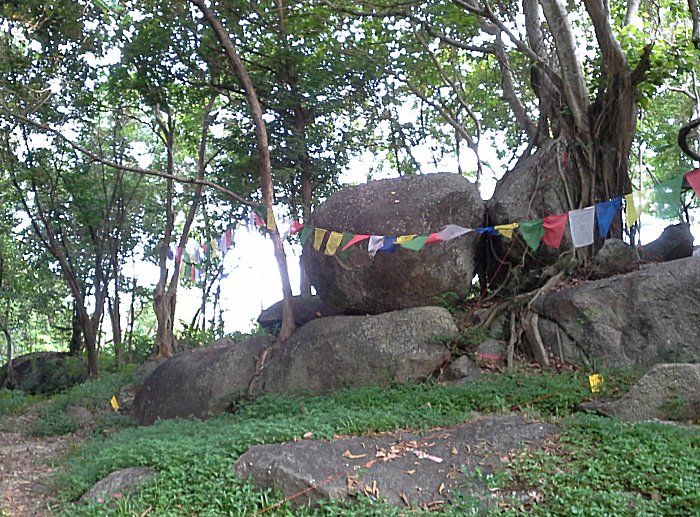 This is likely my final posting from Kamalaya…
This is likely my final posting from Kamalaya…
This posting arrives on my departing day from Kamalaya, and has emerged during my meditations and contemplations, both within the centuries-old monks’ meditation cave, and on top of it. There are three stone ‘tablets’ atop the cave, and I have taken occasionally to sitting upon one of them, with the item of clothing that I use to cover myself, when inside the cave, tucked beneath my posterior for cushioning. This morning, however, I discovered it missing, and when I returned to the ring of stones, I discovered my shirt wet with dew, crumpled and I presume blessed, upon one of the tablet thrones.
Proverb: If one cannot get one’s own way, one must bow to the inevitable.
I begin my quest to write this posting, with reference to Wikipedia, to discover the etymology, and the precise wording of the proverb that has inspired me. ‘If the mountain won’t come to Mohammed then Mohammed must go to the mountain.’ Wikipedia reports: ‘Mahomet made the people believe that he would call a hill to him, and from the top of it offer up his prayers, for the observers of his law. The people assembled; Mahomet called the hill to come to him, again and again; and when the hill stood still, he was never a bit abashed, but said, If the hill will not come to Mahomet, Mahomet will go to the hill.’
Although widely attributed to Mohammed, apparently, there is no written or oral tradition that traces the phrase back to him. However, given that Ko Samui was originally an island entirely devoted to Islam, it seems very appropriate that I make reference to it in my musings. Let me explain the relevance here. The land upon which Kamalaya has been created and constructed has a ‘population’ of bulbous boulders. Some are boulders beyond measurement, so huge are they. They snuggle within each other’s undulations, folds, and soft hollows, intimate and hugging. Some loll in scattered groups within the sand, sitting it out come heavy rain and high tides, cleansed by the rhythms of the Aow Thai ocean. Somehow they remind me of the sculptures of Henry Moore, and I imagine him revelling in their natural propensity to be art forms, exactly as they are. They dominate, and they demand that humans circumnavigate them, for they are not to be moved. And so it came to pass that the humans came to the mountain, and in particular the owners, John and Carina Stewart, and the architect, Robert Powell (for the most part), built Kamalaya entirely with them, and around them, and with the jungle vegetation in mind. There were some exceptions, one imagines ― boulders that could and had to be moved. One senses there was much respectful negotiation, persuasion, ritual thanks-giving, ‘Forgiving and Giving’, in the act of causing boulders to shift ― to shift emotionally as well as physically. Perhaps each stone have inner recording abilities, like a ‘stone tape’.
Vitamin-enriched nutritional vocabulary
These boulders had listened for centuries and now stood as grounded, loving, rooted, meditative monks. They had surely imbibed the nutritional chanting and prayers of the Arjan monks, and others who had blessed the land. Words, phrases, sentences, centuries-old utterances, and mutterings, whispered by sages ― repeated incantations and prayers resided in their boulder-bodies. Permissions from the population of boulders were essential for Kamalaya to emerge, and to grow within nature’s natural, flourishing camouflage. And so arises another saying…
There is an Elephant in the Room
Again I refer to Wikipedia, to discover more about this English metaphorical saying. ‘There is an elephant in the room’, refers to: ‘an obvious truth that is either being ignored or going unaddressed. The idiomatic expression also applies to an obvious problem or risk no one wants to discuss. It is based on the idea that an elephant in a room would be impossible to overlook; thus, people in the room who pretend the elephant is not there have chosen to avoid dealing with the looming big issue.’ It is a kind-of old fashioned expression perhaps. Just like ‘tickety-boo’, which I love. So here I am pondering the expression with reference to these stones. Let me enlighten you more.
Have you experienced an Elephant in the Room, in a therapeutic context?
Most of us probably have, and most certainly within the unique context of our own lives. Consider then the beautiful comedic idea of truly having an elephant in the therapy room! I refer again to God having a sense of humour. Well in this context it may well be that the architect had a sense of humour as these elephantine boulders do indeed find themselves in therapy rooms. You also find them barging in to guest accommodation balconies, or pushing the boundaries on pathways and stairways. Such bare-faced stone cheek! They get very up close and personal. They have been embraced with skill, and ‘house-trained’ within certain interiors, such that a boulder is partly within a space, and partly outside, with the external half remaining within the jungle landscape. Some have surrendered themselves to embellishment, and fine carving to allow for candle adornments, and offerings. In my ‘luxury cell’ the balcony rail appears to be channelled through the upper body of a boulder ― a reverential piercing, one might say. Look closer and one discovers that the railing of the balcony skirts very neatly up to the boulder, such that the elephant can relax and continue to enjoy the terrace in meditative mood.
Free-range …
These are free-range boulders, sitting in the midst of other boulders, stroked by the ever-growing verdant jungle. Another day of peaceful, contemplative bliss ― a power for good in Kamalaya’s mindful sanctuary of wellness. All is in peaceful accord.
And who other than the Kamalaya community comes to mingle with the mountain today?
The monks continue to come. Buddhist Monks from Kunaram Temple came to hold a blessing ceremony on the occasion of Visakha Bucha Day (Friday 24th May), when Buddhists gather together in worship, to recollect the wisdom, purity, and compassion of the Buddha. The day is particularly auspicious in Buddhism because it celebrates three very important incidents in the life of The Buddha: his birth, his enlightenment, and his passing away, all of which miraculously fall on the same month and date – the Vesak full-moon day of the 6th lunar month. The cave absolutely shone with candlelight on that particular day.
wp-site11
Latest posts by wp-site11 (see all)
- “Sleep on it” and other Megalithic musings - August 8, 2014
- Barefoot Bohemian in Bangrak (Bang Rak), Ko Samui - June 19, 2014
- Memories Maketh up Our Minds: Part II - June 15, 2014



I love your wit. I love how well you express your appreciation of the wounderful boulders at Kamalaya.